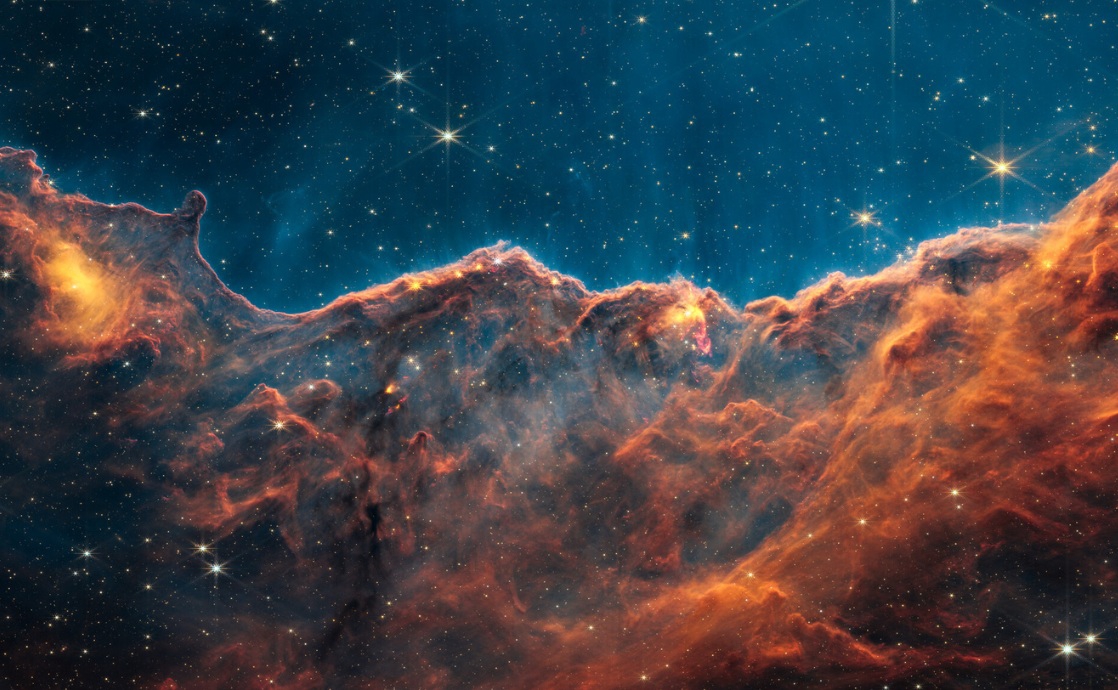The views expressed in our content reflect individual perspectives and do not represent the authoritative views of the Baha'i Faith.
A few months ago, I woke up at 3 a.m., went outside, and watched the Perseid meteor shower for an hour. As those flaming fireballs scored the heavens with their blazing light trails, I saw the Creator.
Well, not the unknowable Creator, of course, but instead, I witnessed the fiery traces of the overwhelming and awestruck creation in a mesmerizing light show of its spectacular glory.
A meteor shower always reminds me of the absolutely astonishing beauty that awaits us every evening when our diurnal sphere, which humanity has watched and studied and marveled over since the beginning of our species, shines its starlight down on us all.
To paraphrase Sinead O’Connor, “nothing compares 2 U,” universe.
RELATED: Does the Smallest Thing in the World Hold a Secret to Our Universe?
As I watched the meteorites streak the sky — there goes another one! — I wondered about the nature and origin of existence itself. As I tried my best to meditate on the unknowable, suddenly a baffling phrase from the Baha’i writings occurred to me, from Abdu’l-Baha’s book Some Answered Questions: “… absolute non-existence lacks the capacity to attain existence.”
Then how and when did all this get here? Those questions, sooner or later, occur to just about everyone. In essence, they’re mystical questions related directly to our origin stories.
By the latest rough astronomical estimate, the universe holds maybe 200 billion trillion suns. Let that sink in for a minute.
Our home galaxy, the Milky Way, contains somewhere in the neighborhood of 100 million stars (and at least that many planets). Multiply that by two trillion — the mind-boggling number of galaxies in the universe, according to estimates gleaned in 2016 from Hubble telescope observations — and you get 200,000,000,000,000,000,000,000, so many stars they could not be counted in millions of years of continuous counting. (The World Atlas has a good introductory article on this incalculable calculation if you’d like to learn more — or just be completely overwhelmed by the unknowable vastness.)
But that astronomical figure only represents the limited view of the universe we can now see. Let’s stick to that limited horizon for a minute and figure out what it might mean.
How to See Infinity
Want to see infinity? Just go outside after the sun sinks into the west and look up. The night sky, black as velvet and vastly perfect for stargazers and meteor mavens like me, offers itself to all of us lovingly and freely, with no agenda, no ticket price, no requirements, reservations unnecessary and conveniently located directly above in 180-degree black-and-white stratovision.
That stunning darkness openly unfolds an overarching vista of humanity every night. Its ubiquity invites everyone to stare out into eternity and contemplate our world, our galaxy, our lives, our fates. Its mystery serves as an endless source of fascination for humanity and always will.
Everybody has equal access, unless, of course, you live in a star-blocked city that produces an obscuring penumbra of manmade glare. If that’s the case, I’d recommend seeking out the real-life twinkling heavens by leaving the city for one night and going somewhere dark. (Here’s a dark sky map.) You’ll be astonished, star-starved urbanites, by what’s up there — an infinitude of suns blazing away in trillions of galaxies as far as the eye can see and much, much farther.
As I looked into the heavens, in new moon darkness, the long luminous edge of our galaxy shone so bright here in the Northern California Sierras that the Milky Way cast shadows. (If you’ve never seen your star-shadow, it’s a must.)
The entire universe, aglow, its lights blazing out, made me think about those two perennial issues long debated by both science and religion: how big and how old is our universe, anyway?
You can’t help contemplating those eternal questions when you stargaze.
Scientists have tried to answer them ever since science has existed. We’re still attempting to figure out, right now, how old and how big the universe might be. Today, though, we’re using advanced scientific instruments like the James Webb Space Telescope, with its unprecedented ability to peer back through eons of time toward the origins of the cosmos.
So, let’s get up to speed with the latest science: what do we know now that we didn’t know before?
Stargazers and Scientists of Antiquity
The first observers who recorded their findings about the universe, probably the 16th-century B.C. Mesopotamians living in the Fertile Crescent looked up at the night sky with the naked eye and concluded that our planet was a flat, circular disc floating in the absolute center of a cosmic ocean. Ten centuries later, the ancient Greeks declared that the Earth wasn’t circular and flat at all, but instead was a sphere. (Take that, Flat-Earthers) It was the pre-Socratic Greek philosopher Parmenides who figured that one out — but he still maintained that the Earth was the center of the universe.
Not until Plato, Socrates, and Aristotle did anyone attempt to assign an age to the universe. Aristotle believed, even though he supported the old Earth-as-the-center-of-the-universe theory, that the universe around our home planet was infinite in time, but not in terms of matter.
These 4th century B.C. ideas held sway only until the 3rd century B.C., when Aristarchus of Samos figured out that the Earth rotated on its axis and orbited around the sun — which he thought of as the center of the universe. His heliocentric theory lasted for several centuries until Galileo Galilei and his famous telescopes found out, much to the consternation of the Catholic Church, that our Earth and our sun had a non-Biblical relationship. (Mr. Galilei is now recognized as the father of observational astronomy, modern-era classical physics, and the scientific method. Albert Einstein called him the father of modern science itself. Not bad for a heretic.) He also suspected, by the way, that we, humanity, and our planet, Earth, are not the center of the universe. Humility triumphs.
The Big Bang, and What Came Before
Modern science has progressed well past Galileo’s observations, as he predicted it would. We now think we know, with a relative degree of certainty, the age of our universe: approximately 13.8 billion years, give or take a few billion. If you subscribe to the Big Bang theory, that age calculation has become a pretty well-founded scientific conclusion at this point — but even ardent Big Bang believers understand that some form of existence had to precede that alleged instant of creation because, as far as we can tell, something was never created from nothing — as Abdu’l-Baha pointed out. We may never know, although theories abound — and many of them recognize the need for a pre-Big-Bang multiverse or at least the existence of matter and energy in some form prior to that Bang.
The Big Bang theory, however, does not fully explain the origin of the universe, like many people seem to think it does — that’s a popular misconception, one that probably arises from our all-too-human tendency to assign beginnings, middles, and ends to every narrative. The Big Bang theory doesn’t actually offer much in the way of explanations for how energy, space, or even time itself first came into being — instead, it simply describes one of the scientific possibilities for how our vast universe grew out of a theoretical “singularity,” a superheated, ultra-dense state of mass and energy, likely preceded by other states of being we know nothing about.
RELATED: Finding the Hidden Mysteries in Ourselves – and In the Universe
The Baha’i Conception of the Eternal Universe
Given all of this relatively recent scientific knowledge, it might surprise you that the Baha’i teachings have a great deal to say about the age and size of the universe. After all, one of the primary principles of the Baha’i Faith — the agreement of science and religion — offers us a way to accept both.
Baha’u’llah’s son and successor Abdu’l-Baha, in his book Some Answered Questions, offered a detailed explanation:
… the very names and attributes of Divinity require the existence of created things. … Know that a lord without vassals cannot be imagined; a sovereign without subjects cannot exist; a teacher without pupils cannot be designated; a creator without a creation is impossible; a provider without those provided for is inconceivable — since all the divine names and attributes call for the existence of created things. If we were to imagine a time when created things did not exist, it would be tantamount to denying the reality of God.
Apart from this, absolute non-existence lacks the capacity to attain existence. If the universe were pure nothingness, existence could not have been realized. Thus, as that Essence of Oneness, or divine Being, is eternal and everlasting — that is, has neither beginning nor end — it follows that the world of existence, this endless universe, likewise has no beginning. To be sure, it is possible for some part of creation — one of the celestial globes — to be newly formed or to disintegrate, but the other countless globes would continue to exist and the world of existence itself would not be disrupted or destroyed. On the contrary, its existence is perpetual and unchanging.
The Baha’i writings clearly describe the universe as endless, boundless, and limitless.
That’s a difficult concept — for me, at least — to try to comprehend. I think: doesn’t the universe have its boundaries, its limits? No, it does not, the Baha’i writings contend — instead, creation itself reflects the nature of the infinite Creator:
Likewise, look into this endless universe: a universal power inevitably existeth, which encompasseth all, directing and regulating all the parts of this infinite creation; and were it not for this Director, this Co-ordinator, the universe would be flawed and deficient. It would be even as a madman; whereas ye can see that this endless creation carrieth out its functions in perfect order, every separate part of it performing its own task with complete reliability, nor is there any flaw to be found in all its workings. Thus it is clear that a Universal Power existeth, directing and regulating this infinite universe. Every rational mind can grasp this fact.
I’ll admit it — my own finite, limited, rational mind struggles mightily to perceive or even imagine the infinite. Just as a drop can never understand the ocean, our human consciousness cannot comprehend an unlimited universe — or the great might and power such a limitless creation suggests about its Creator. Maybe that’s why watching the stars has such a powerful spiritual effect.
You May Also Like
Comments

















"Know thou that the Kingdom is the real world, and this nether place is only its shadow stretching out ..."
"... it is sanctified from what we call ‘time and place.’
Time with us is measured by the sun. When there is no more sunrise, and no more sunset, that kind of time does not exist for man."